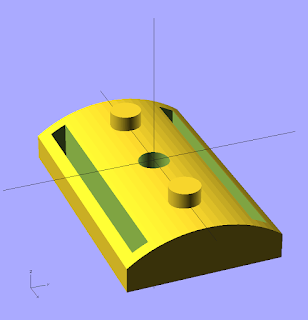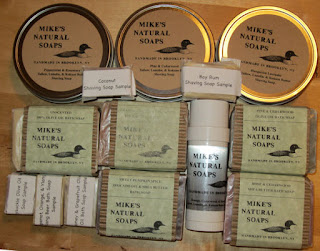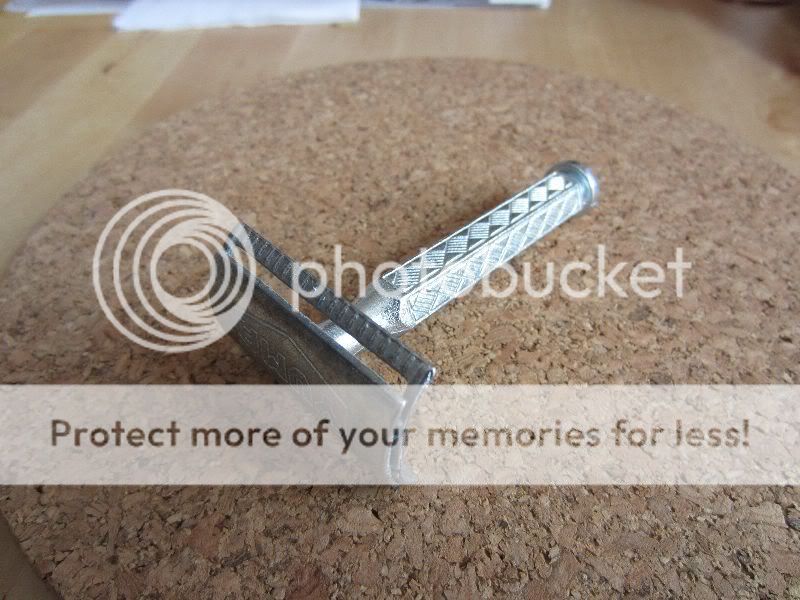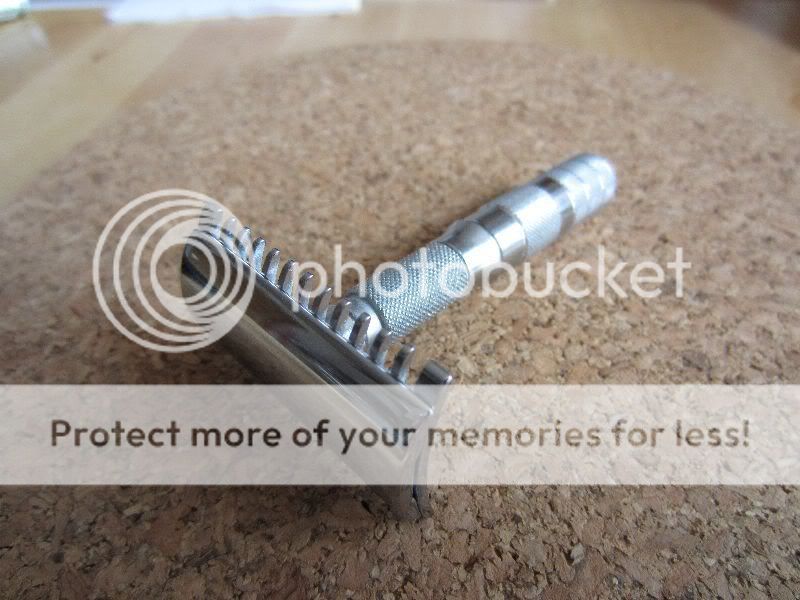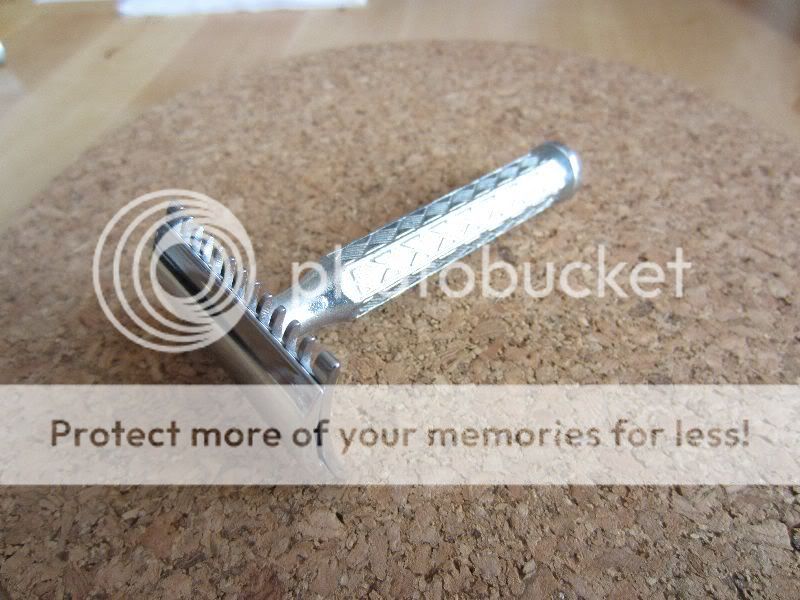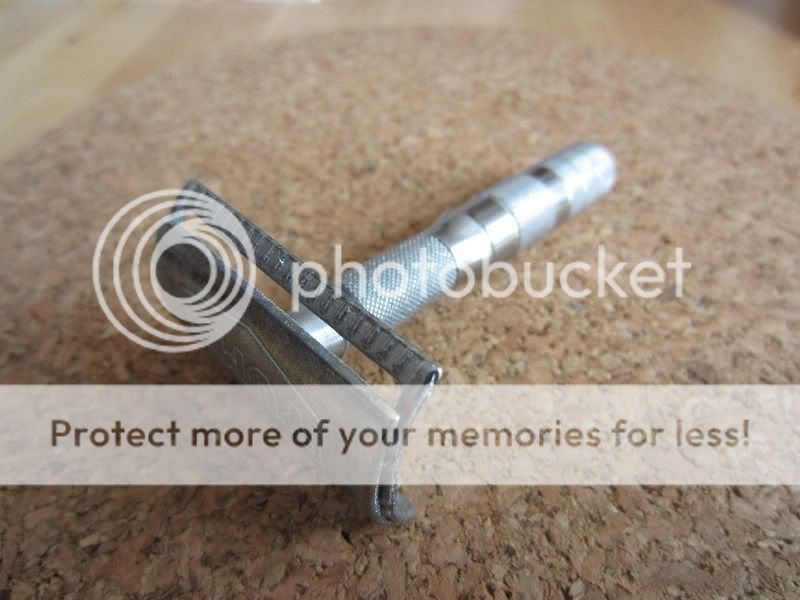I am slowly – very slowly – getting to grips with the skill of using OpenSCAD to describe things. So far I’ve managed to come up with a ‘parametric’ file, where I can alter a variable or two to create different versions of the same object. And while the two extremes might be way too mild or way to harsh to shave with, the one in the middle might work reasonable well…
Category Archives: Wetshaving
Playing with plans for 3D printed razors
Pay It Forward
Wetshaving in the internet-age isn’t just about getting a damn fine shave while (potentially) spending significantly less money that you would if you went for canned goo and cartridges.
It is also about – at least for some of us – social interaction with others with whom we share a hobby. Being active on an online forum means you get to share hints, tips and sometimes more… many wetshavers are happy to Pay It Forward, which can both serve to give other shavers a chance to try something new as well as culling the horde some of us accumulate.
To mark my 1000th post over at The Shave Nook – a very friendly and open minded shaving forum – I decided to pay forward a tub of Mama Bear’s Brazilian Coffee that I’ve barely touched. With luck the guy who got it will enjoy it – and in time pay the favour forward.
Angle of Attack
If you’ll excuse the aeronautical term, the angle of the blade have been somewhat on my mind lately – not the angle it has in regards to the razor (which differs between various razors), but the angle it has in regards to the skin when it cuts.
It is – like many other things – the fault of the cartridge shaving systems… the so called modern razor tends to have a flexible head, which is supposed to make shaving easier. A cartridge razor teaches us a lot of bad habits – use of excessive pressure is the one mentioned most often, but just as bad is the lack of proper angle… and when shaving DE (or SE) the angle of attack is alpha and omega in my opinion for getting that great shave.
The head of a traditional safety razor does NOT pivot. Therefore the pivoting action have to come from the wrist – making shaving a little more labour intensive, but more importantly giving the shaver near perfect control… unlike a wibbly-wobbly plastic hinge.
Maintain proper AoA at all times – and check your six for bogeys.
/ for a more complete discussion on the how and why of the shaving angle, please see this article over at the Badger & Blade wiki
First loot of the year 2013 – soap
Looking back
Franken-nought-four
My first frankenrazor – or technically speaking, my first two.
First off, this is the Merkur 41C – also known as the 1904 – which is a razor with a good reputation, and one I don’t own:
I noticed that the head of the 1904 looks just like the heads on my Merkur 25C long handled open comb and my Merkur 985CL travel razor. It seems like the Merkur three piece OC’s all share the same style head…
As an interesting sidebar, I found while dredging the web for information on the 1904 and Merkur OC in general that they were actually intended to be adjustable… by loosening the handle 1/8 to 1/4 turn you can adjust the blade angle and gap, while the springiness of the blade should keep the mechanism tight. Needless to say I’m not too keen on trying it out… shaving with a loose head? Anyhow, back to the frankenrazor.
I also noticed that the nice handle of the 1904 looks very much like the handle of my cheap and cheerful Yuma – even if I do believe the Merkur handles are of a much, much better quality, finish and alloy than the cheap Yuma.
Cue wheels spinning…
Gentlemen, allow me to show you something:
Drummroll please…
I could also have used the head from my Merkur 25C, in which case the leftovers would have given me a long handled Yuma. However there is a blade in that razor right now, and I’m not too keen on opening razors before it’s time to ditch the blade.
How the frankenrazors shave? I don’t know yet… but I am going to find out soon enough!
How to introduce traditional shaves to the cartridge generation?
I really, really enjoy shaving in the old fashioned way; soap, brush and double edged blade. I enjoy it so much I rather go for the cave man look than having to use a cartridge or electric razor – in fact, I enjoy it so much I want to share the enjoyment with the world!
There are several reasons for wanting to share. At the very core, I find it to quite simply to give a much superior shave and a much, much more enjoyable experience in the bathroom. Then you have the enjoyment of trawling the various online shops in the various corners of the world – from Turkey to Brooklyn NY, from Spain to the UK. And not to forget, the fun of talking to like minded shavers from even further abroad online.
Which off course leaves the question of how to properly introduce others to this all too absorbing hobby of mine… without coming across as a weirdo or worse. Not an easy one to answer, that is for sure.
One thing I have considered is assembling a Pay It Forward Starter Kit – PIFSK – and hand out as gifts. A quick look around shows me that I can assemble a decent one for less than 10 USD, meaning no one will be heartbroken if the recipient finds that old fashioned shaving isn’t for him (or her, for that matter).
Such a kit would most likely consist of a Turkish No6 brush, a stick/tube of Arko soap/cream, some good blades and a cheap but good razor – right now the choices are between the Yuma and Racer razors; neither of which can be said to be expensive razors. Add to that a card with some quick instructions*, some links to places online to learn more and perhaps some pointers on brush and razor care… printed out on nice, thick paper.
I have gotten both a Yuma and a Racer from turkey, and both actually shave remarkable well. I just need to find out what bades do and don’t work with them, which off course would mean trying them with several blades I consider good to find the best match… or maybe two best matches.
Then it’s “just” a matter of creating a presentable box and find out who the recipient will be… and that might be the hardest part of it all.
*) Wash face. Rub shave stick over stubble. Use wetted brush to build lather directly on face. Shave with short, controlled strokes while maintaining proper angle. Rinse face. Apply more lather. Shave again. Rinse well. Apply aftershave or balm of your choice.
I’m a geek – a shaving geek
Having spent a fair bit of time the bathroom most mornings, shaving my stubble off, I one morning received a revelation: I am a geek*.
Not that it’s a great shock to me; I’ve been pretty sure of my status a a geek since I was in school.
What caused the revelation is that I suddenly grasped what part of being a nerd is: A nerd will pursue an interest in depth, with great enjoyment and with scant regard for what the “normal” people think.** For example; If a “normal” person needs a computer, s/he will buy a desktop or a laptop and use it until it needs replacing. If a geek needs a computer, s/he will end up with, well:
- Two desktops in use (mine and my better half each have one) with dual screens
- Two desktops on standby, with three screens between them
- One laptop in use
- One laptop on standby
- Three Netbooks (two for me, one for my better half)
- Two tablets (a Samsung Tab2 and a HP Touchpad)
- and one ultra small form factor computing device…
Anyhow, back to my mornings: As mentioned, I was getting the stubble of my face while I was letting my mind drift and enjoying myself immensely. Actually enjoying shaving myself is still somewhat of a novel experience for me, since for the majority of my adult life shaving have simply been a chore at best and resulting in a bad case of razor burn at worst. Electric razors have always felt like they were ripping my beard out, and the various latests, greatest razors put out by Gillette have been like dragging a dull knife over my face – didn’t matter if it was two or five blades, nor what can of foam I used. Shaving was a chore and something I just got over with as soon as I could.
Not so no more.
Shortly before I deployed to Africa for a twelve month Tour of Duty my better half directed my interest towards the recent resurgence of classic shaving; that is shaving with a brush, some soap or cream, and a simple one-blade, two edged safety razor of the kind your grandfather used. I figured I would give it a try and ordered a starter-kit from an online retailer in Norway – at the very least I would not have to worry about charging my electric razor or getting cartridges for my system razor while in Sudan…
Remember my comment on what will happen if a geek needs a computer?
Well, these days a typical day starts with me picking out the days combo of razors, brush and lather, before doing a bit of prep: a throughout wash of my face with pure castille soap while the brush soaks in warm water. After the prep I load the brush up, make lather and starts shaving – smiling all the time.
So yes, if a “normal” person needs to shave, he’ll pick up an electric razor or whatever wunderbar new system one of the big names sells at inflated prices. If a geek needs a shave, he might end up with a new hobby and an array of kit:
- A Parker 22R butterfly razor – a good first razor, and a wonderful one for the second pass.
- A Merkur 39C slant bar – a more aggressive razor, and not one for those just starting out.
- A Merkur 985CL open comb travel razor – sits somewhere between the 22R and 39C, and usually in my GoBag. I sometimes takes it out and uses it at home though…
- A Feather Popular razor – remarkable mild, but requires a fairly light touch
- A Racer razor from Egypt – untried so far, but gotten good reviews online
- A Yuma razor from Turkey – cheap, untried but also gotten good reviews
- Two Body Shop synthetic brushes – a decent enough brush and a good one for travelling; it dries quickly. So I got one in my GoBag and one at home.
- An Omega Shaving Brush #10048 Boar Bristle (box branded as Prosaro) – came with my starter kit and is pretty okay; handle is a bit on the big side for me.
- A Turkish No6 horse hair brush – wonderfully stiff and can make good to great lather out of anything.
- A Turkish No7 horse hair brush – same knot as the No6 as far as I can tell, but with a different handle.
- A Vie-Long #14033 mixed horse-badger brush – still in the process of breaking it in.
- A tub of Maca Root shave cream from Body Shop – procured before I started with classic shaving, and a pretty decent shaving cream. Contains a fair bit of nasty chemicals though… will probably not get a new one once the current tub is empty.
- A tube of Proraso eucalyptus and menthol cream – part of my starter kit and my sole cream while in Sudan; I like both the scent and the soft glide it has. Used to live in my Gobag, but have been ousted by a newer cream.
- A tub of Proraso eucalyptus and menthol soap – pretty much the same as the cream, but as a soap. A little harder to build the lather, but that’s partly down to skill.
- A tub of Crabtree and Evelyn Sandalwood soap – smells great and works great.
- A stick of Arko shaving soap – some people online swears to it, and some swears at it. Like everything about classic shaving, your mileage may vary considerable. I rather like it myself, once the strong scent had worn off a bit (hint; leave it unwrapped).
- A tub of Col. Conk Bay Rum shaving soap – my first bay rum. The scent is subtle and good, but it reminds me of something I can’t quite put my finger on – not anything bad, mind you.
- Several samples of tallow, lanolin and kokum butter shaving soaps from Mike’s Natural Soaps: Lavandin & Eucalyptus, Barber Shop, Rose & Cedarwood, Orange, Cedarwood & Black Pepper, Lime, Peppermint & Rosemary, Pine & Cedarwood, and Unscented
- A tube of Nivea Shave Cream – a solid performer, generously PIFed from a fellow shaver. Sits in my GoBag most of the time, I’m always careful to put it back after using it at home.
- A tube of Rise Shave Gel – generously PIFed from a fellow shaver.
- A tub of RazoRock XXX Shave Cream – generously PIFed from a fellow shaver.
- A tub of Orange Essential Oil Shave Soap – smells great, generously PIFed from a fellow shaver.
- A refill pucks of Mitchel’s Wool Fat Shaving Soap – generously PIFed from a fellow shaver.
- Samples of Martin de Candre and TFS Bergamotto Neroli Soap – both solid performers, both generously PIFed from a fellow shaver.
- A tube of Aubrey Organics North Wood shave “cream” – for use without a brush. Not too impressed with the glide, okayish for travelling. Backup for the tube in my GoBag.
- An alum block – an antiseptic and astringent, it’s used to clean and seal any minor nicks. Stings a fair bit if you got a larger nick, and tastes really weird if you get it on your lips.
- Proraso Liquid Cream Aftershave – a pleasant smell in my opinion, YMMV though.
- Krampert’s Finest Bay Rum Aftershave – generously PIFed from a fellow shaver, and a very nice aftershave indeed. I miss it badly when I’m shaving from the GoBag.
- Three bowls for making lather in – a copper bowl from Turkey, an “at home bowl” (intended by IKEA as a cereal bowl), and a Turkish acacia wood travel bowl.
- A selection of blades; Feather Hi-Stainless, Trent, Zorrik Super, Merkur Super, Willikins Sword, Gillette 7 o’clock, Astra Superior, Lord Platinum, Shark Super Chrome, Personna Platinum, Derby Extra, Persona Super…
Off course you don’t need so much to make shaving enjoyable again; on my recent ToD to Sudan I had only my Parker 22R, my synthetic brush and the tube of Proraso cream – but I find that having to make a couple or more choices in the morning adds to the enjoyment. And compared to some people out there my combined kit is definitely on the small side…
The actual shave itself has become somewhat of a ritual, a very comfortable and manly ritual. First I’ll wash my beard stubble with some Dr Bronner’s all natural castille soap, which helps soften up the stubble and prevents the oil on my skin from breaking down the lather. Having done that, I’ll rinse off and start laying out the tools of the trade; my razors and the combo of brush and soap / cream I’ve decided upon. After soaking the brush in warm (not hot) water, I proceed to adding wetness to the stubble with the brush. This both softens the brush some and gets the water down between all my stubble. Then it’s time to build the lather, and how I do that depends a bit on what soap / cream and brush I’ve picked. Some combos work best if built in a bowl (I started out with a cheap plastic bowl, upgraded to a cereal bowl and have just bought a cheap copper shaving bowl), some combos turn out better if built directly on my face.
Having built the lather, it is time to apply it. No reason to put on an inch of lather – the idea is to create a lubricated surface for the razor to glide over, as well as softening the stubble even more. At the end the brush is still heavily loaded with lather, which is good. Putting the brush aside, I rinse the “heavy cutter” of the day under hot water – not to clean it but to prewarm it – and starts the actual shave. Slow, short and controlled strokes does the trick – letting the weight of the razor do it’s work as I guide it. First pass is with the grain, and leaves me with a shave just as good as anything I could manage in the past. I’ll rinse and put away the first razor, rinse my face and apply lather again.
Yes, a second layer of lather for a second pass. I’ve found that my brushes will easily hold enough lather for three passes, even if I mostly stick to two. The second pass is usually with a milder razor, and going across the grain of my beard. Short, controlled strokes, letting the razor work for me again. When done correctly, and with a decent blade, you can actually hear the sharp edge cutting the stubble down to nothingness. A second rinse, check for any obvious misses and then stroke my block of alum across my neck and face to clean any minor nicks and cuts. Then it’s a simple matter of rinsing and putting away the razor, the brush and the bowl, plus cleaning all the little beard bits from the sink. Some people goes for a third pass too, usually against the grain, but I’ve found that two is enough for me.
It may sound complicated, but overall it takes about the same time as using a cartridge razor and cleaning up the resultant mess in my face. My skin is happier, I got a new hobby and gets to enjoy my mornings. And it is cheap to get started too; the initial outlay may be a bit more than using the “latest and greatest” thing from Gillette or the other Big Names in shaving, but when you look at the math it turns out that it can be significantly cheaper in the long run:
A Parker 22R – my first razor – costs 295 kroner (it is far from the cheapest DE razor around), and a pack of ten (10!) Feather Hi Stainless blades costs 40 kroner. Since each blade lasts about a week, that’s about 0.60 kroner a day for shaving.
A Gillette Fusion Power Stealth costs 185 kroner, and a pack of four (4!) cartridges costs 139 kroner. If one cartridge lasts two weeks – which is what I got out of the old Sensor cartridges that is about 2.50 kroner a day for shaving.
In other words, you pay about as much for a razor and a pack of blades independent of your choice of cartridge or DE razor – but you can shave for two more weeks with the DE razor before needing replacement blades. Start factoring in the cost of new blades, and the gap keeps increasing. Your costs may vary depending on where you live off course, but the basic premise holds true: Classic shaving can be significantly cheaper than using cartridges – if anything the cost difference should be greater in most countries. It is also better for the environment; no plastic waste, less packaging and the blades can easily be recycled. On top of that it provides a better, closer and more comfortable shave – so why not give it a try?
A basic starter kit can be pretty cheap; if you live in the US (for example), you can get a basic DE razor for less than 10 USD, a ten pack of good blades for less than 2 USD, a shaving brush for less than 5 USD and a shaving stick for under one USD.
If you’re even cheaper and buys from cheaper places, you can actually get the whole kit for ten USD – plus shipping, off course.
All told a modest outlay that will save you money in the long run, as well as providing you with some personal spa time each morning. You do deserve a bit of pampering, don’t you?
*) Or nerd, or tech-head, or whatever other description you prefer.
**) Other definitions of geek / nerd includes:
– A person who is interested in technology, especially computing and new media.
– Geeks are adept with computers, and use the term hacker in a positive way, though not all are hackers themselves.
– A person who relates academic subjects to the real world outside of academic studies; for example, using multivariate calculus to determine how they should correctly optimize the dimensions of a pan to bake a cake.
– A person who has chosen concentration rather than conformity; one who passionately pursues skill (especially technical skill) and imagination, not mainstream social acceptance.
– A person with a devotion to something in a way that places him or her outside the mainstream. This could be due to the intensity, depth, or subject of their interest.
Shaving brushes
Just like a good lather is alpha and omega for an enjoyable shave, a good brush is alpha and omega for building a good lather. Luckily good brushes are easy to come by, both cheap and less cheap. If you’re just starting out, a synthetic brush from Body Shop or a similar place is more than good enough. Modern synthetic is – apparently – a decent match for boar bristles, but with the added benefit of drying quickly. This also make them excellent brushes for travelling.
Choosing between boar and badger is a subject that is often discussed at great length in various online forums. Personally I have developed a liking for the third option; horse hair brushes. Not only are they cruelty free, being made from mane trimmings, but they also combines a solid backbone, springiness and the ability to hold plenty of water – all qualities that makes them excellent in my opinion when it comes to building a good lather. I also like my boar brush, especially when it comes to building lather from a soft cream, but I’ve yet to try a badger brush… good badger brushes are not cheap.
Much like finding the perfect blade, the perfect brush is a matter of personal preference. At the same time you don’t need to have to perfect brush to get a really good shave, so don’t worry too much about finding it right away.




